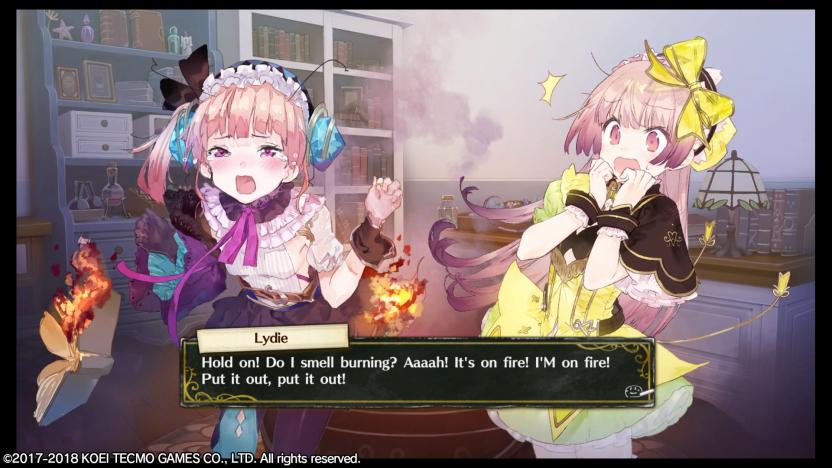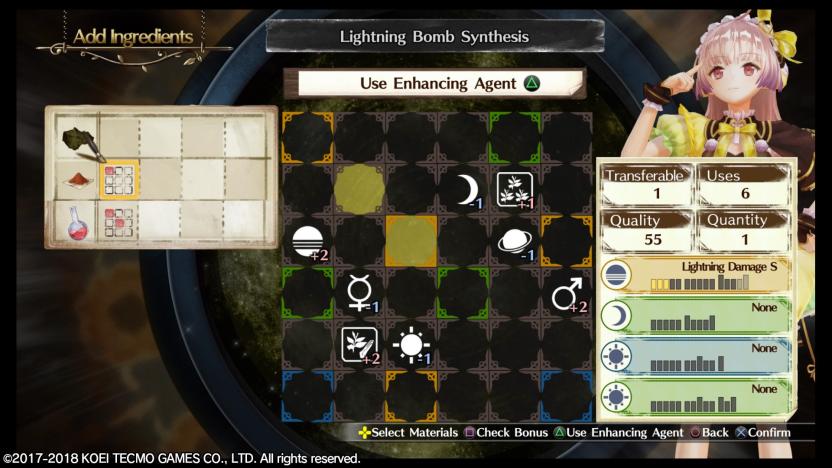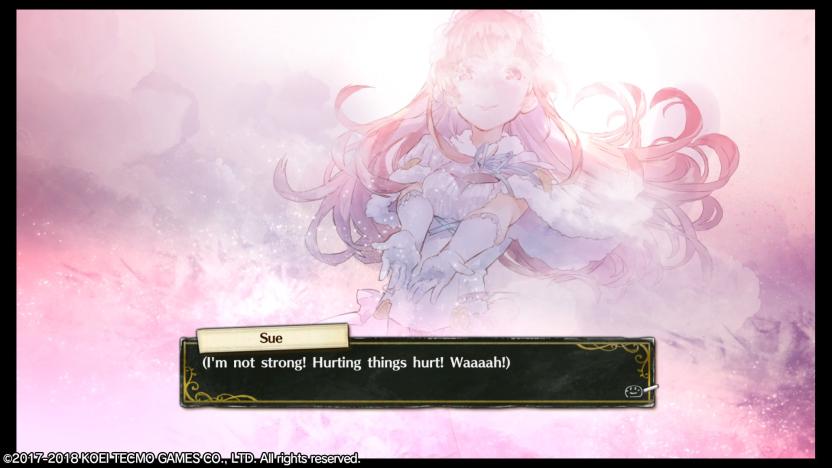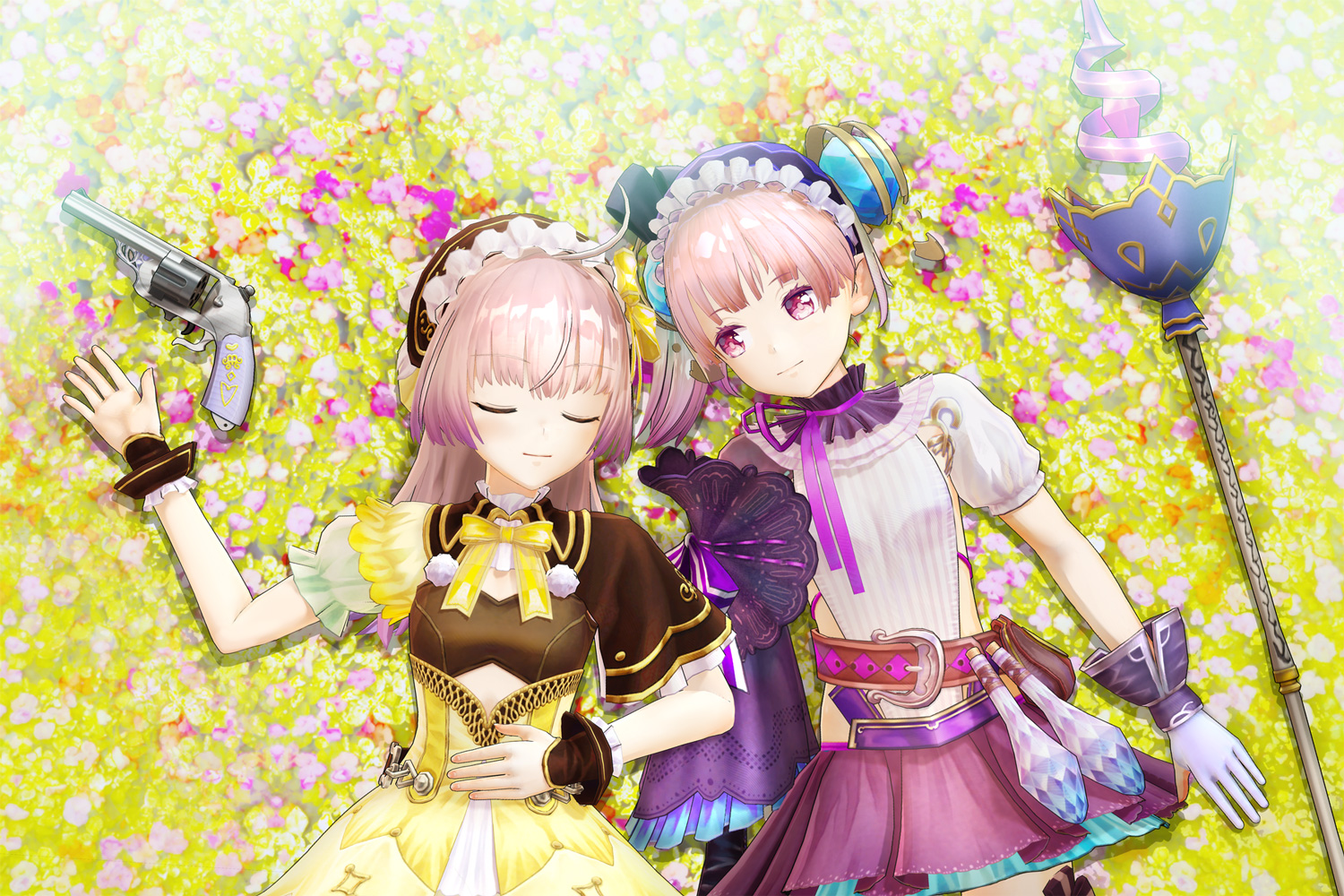The Atelier series, a series I have always wanted to play. Almost every time I step in to a game store, I see some of the previous games for sale and they’ve always seemed very interesting to me. But for one reason or another, I’ve just never picked any of the previous entries up and given them a try. Actually, I take that back. I have picked up at least one other Atelier game. I do have Atelier Sophie: The Alchemist of the Mysterious Book, but alas, I have yet to play that entry. Because of my desire to give the series a try, I was determined to pick up the newest Atelier game and give it a chance. This is why I was so very excited when I was given the opportunity to play and review Atelier Lydie & Suelle. Unfortunately, that excitement only lasted long enough for me to get through the opening scenes of the game, as the game falls flat almost right from the beginning.

Atelier Lydie & Suelle: The Alchemists and the Mysterious Paintings
Publisher: Koei Tecmo
Developer: Gust
Platform: PlayStation 4 (Reviewed), Nintendo Switch, Windows PC
Release Date: Jan 26th, 2018
Players: 1 Player
Price: $59.99
Now granted, I am coming in to the series extremely late in game. There are 18 other entries with Atelier Lydie & Suelle being the 19th game and the third in the Mysterious series. Luckily, you really need no previous knowledge about the other games in the long lived series to understand and dive right in to the newest installment. For all the other shortcomings found in AL&S, Koei Tecmo did a good job of introducing the previous protagonists and making it so that players did not feel overwhelmed if AL&S was their first foray in to the Atelier family of games.
Atelier Lydie & Suelle: The Alchemists and the Mysterious Paintings follows the lives and exploits of the twin alchemists, Lydie and Suelle Malen. Most of the game takes place in the nation of Adalet, mainly focused in the royal capital of Merveille. At the start of the game, the twins are attempting to manage and run their failing family Atelier (the series name for Alchemist shops) while their father fails at both alchemy and art. Both of the twins are driven by promises made to their deceased mother. Their main desire is to have the best Atelier in the nation.
Early on in the game, the nation opens up the Atelier Ranking System, an attempt to draw in more accomplished Alchemists and also give some much needed training to the Ateliers and Alchemists already in the nation for an undisclosed reason, at least at the beginning. For the majority of the first half of the game, the girls are sent on seemingly random tasks for the nation, from gathering eggs to eradicating “dangerous” monsters. Not only that, but once they find the mysterious, living painting in their own basement, they are told by the princess in hiding that the nation itself is searching for more of these mysterious paintings and is attempting to explore and understand their nature.

This basic premise is what originally drew me so heavily towards this game. Each painting that the twins and the player discovers becomes its own unique dungeon that becomes available, initially, once the twins successfully complete each new requirement to climb the Atelier ranks. I will admit, the descriptions and general design of each painting is almost beautifully done. I almost rejoiced each time a new painting was revealed. Almost. But after the first non-tutorial painting, the flaws in the game quickly become very, very apparent.
Generally speaking, you will get small spurts of actual storyline interspersed with long, drawn out elements of running about attempting to garner enough recognition for the twins Atelier. Once you’ve done enough inane side quests, gathering or literally jumping in place, you’ll get a message saying that you’ve increased your recognition to take on the next advancement test at the capital. Now, during these times where you’re attempting to increase your rank, various important locations on the map will show you an icon where the “slice of life” moments of the game will take place.
Here, you’ll learn more about the twins or the various important NPCs of the game. While initially entertaining, like most things in AL&S, they quickly become tiresome or just incredibly saccharine that you’ll just want to try and skip through them as much as possible in order to see if the little scene you just watched will lead to a quest that will give some sort of valuable item or perhaps a boon for the twins, or maybe even a new alchemy recipe.
Usually though, these little moments just give a bit of background information for different characters in the game. While not a bad thing generally, the overabundance of such scenes almost each and every time you do any minor thing in the game quickly leads to most of these side scenes to just become more of an annoyance than anything else.

Beyond all that, there’s the distinct lack of any sort of exploration in the game. The world of AL&S breaks down in to 2 different locations: “Real World” locations, various locals near the main city, and the mysterious paintings. The “real” locations are things you would notice in any standard JRPG: you’ve got your local forest, the further forest, the swamp area, the desert area, and a few other locations. Most of these locations only have 2 to 3 “rooms” that you’ll get to explore and investigate.
Throughout each room, there will be various gathering nodes where you can pick up additional alchemy materials and your standard roaming monsters. Defeating monsters will possibly garner you additional materials and some small amount of gold. The mysterious paintings are basically the same as the real world locations, but with a more dramatic flair. The idyllic forest area, the frozen tundra and palace, the volcano zone… you get the idea.
Unfortunately, the mysterious paintings don’t offer up anything new or exciting except for higher quality or different types of alchemical materials. After their dynamic and, well, “mysterious” opening screens, there’s really not much to do in each painting. You can kill some of the newer monsters to gather up some new materials, you can gather from the new nodes and you can… basically just run to the last room of the painting, get told you need to make some new alchemical contraption that the game just gives you the recipe for, run back, see a cut scene and then get right back to doing inane side missions to raise your Atelier rank.

The biggest aspect of the series, the Alchemical recipe and crafting system, is in full force in AL&S. Early on in the game, since the twins have only a basic grasp of alchemy, you only have a few recipes and no customization ability with your crafting. As you progress through the game, the twins will gain a teacher who teaches them the ins and outs of Alchemy in general, and they quickly progress in ability and overall knowledge.
You start with just the ability to throw some materials together and create the item you’re wanting to make. There’s no chance of failure outside of story segments, so what you want is what you get. Later on, you have the ability to augment your crafts. This means you get to set a base item that changes the layout of the grid in which you place the different materials.
You can even change the colors of your materials, increasing the likelihood that you’ll be able to unlock greater damage/more healing/other beneficial side effects of the recipe you’re making. Unlocking the augments on an item can even lead you to learning new recipes for different items and augments for weapons and armor.

The biggest downside of all this? You can never just mass produce multiples of different items. You can’t just, for instance, make a dozen or so bombs at one time. Or a dozen sheaf’s of paper or anything else that you’d want to have multiples of.
Luckily, even though you can usually only make one of each item at a time, those items usually have multiple uses. Your bombs, for example, can be used at least 6 times before you’ve used up that bomb and need to make more. You can use the different healing items several times as well. A few items, like the neutralizers and other items that affect other recipes, you can usually get multiples of those from each crafting.
There is a fairly decent plot twist about halfway through that explains exactly why the kingdom implemented the Atelier ranking system and why certain items are requested during the rank up exams. Afterwards, the story continues on in much the same way, with a bit of story followed by even more side missions. I was extremely let down by the way the story played out and just how repetitive the dungeons and locals on the map became.
Not only that, I was also let down by the almost extreme battery of side scenes every time you did something. Sometimes, you’d be in the middle of a string of crafting to make an item needed for a quest, only to be interrupted when you finish one item by a cutscene focusing on a different side character asking for a different item, in which you’re interrupted by yet another scene from a different character talking about how great a new sweets shop is followed by the twins gushing over it.

Not only are the characters saccharine beyond belief, but there is no English dub option like in previous games, which is not generally a problem if you enjoy Japanese games or media.
Reading subtitles you eventually get used to when enjoying media from outside your own nation. The localization and translation in AL&S isn’t the most terrible I’ve ever come across, but there are syntax issues and spelling mistakes peppered all throughout the game.
If there were no other issues with the game, if it didn’t drag on and if the character voices were a bit more tolerable, this wouldn’t be any more than a hiccup.
However, when you’re going through the story and you’re being interrupted every other moment, the errors become more and more noticeable. It doesn’t happen often, but it is extremely noticeable when you pick out an error or two per speech segment.

One of the few shining points in the game is the combat, and even that gets muddied down and becomes a chore. Still, AL&S has a fairly decent combat system on the surface.
You get 6 character slots in which 3 characters are put up front as your primary combat line and the last 3 spots are your support characters. Depending on what actions you take in combat, your support characters might make a follow up attack, provide stat/combat boons, enfeeble your opponent, heal you… all sorts of beneficial actions.
On top of that, you can swap the positions of your characters while in combat. Well, you can swap a character with whoever is designated as their support. For instance, say Lydie is one of your combat characters and Suelle is placed behind her in a support role. Lydie can toss out a few buffing spells, toss out a bomb or a healing item.
If things become hairy or you need more attack power, you can swap her out for Suelle, who will now become an attacker and Lydie will back her up. Unfortunately, you can’t make a support character an attacker if both characters in a row are defeated. So if you get caught in an unlucky combat situation, you may find yourself with only one attacker, even though 2 of your characters are still able to fight.

Speaking of bombs… even though you’ve got 3 attackers and 3 support characters with a fairly decent combat system, most of the time combat will devolve into you creating as many bombs as you can, putting characters who can use them in the attacker slots and tossing them out as quickly as you can. It generally causes the most damage for least amount of resource cost. So while you have a diverse cast of characters with different combat abilities, you end up just using the same few combat options (the tank uses his provoke ability, one of 2 characters uses a defense down attack and then you toss out bombs and heals as needed).
So once again, something that had a real chance of being something that would actually make the game at least resemble fun, is broken down and becomes more of a chore than anything. The biggest insult is that the items that allow you to gather different types of alchemical materials, heals, bombs, all of it, take up general space in your inventory. So while you need to go out and gather more materials to complete alchemical recipes, the very items you use in battle and in the field to help you out, take up space, limiting exactly how much you can gather in any foray to the field or paintings.
Now granted, there are ways to increase storage and inventory space, but again, that generally involves suffering through the massive amounts of cut scenes that break up the overall gameplay and completing the different requests that will be interrupted by yet more cutscenes. These requests usually involve asking for more than just a few items to be created and delivered in order to complete them. One quest required over a dozen pieces of wood that were also used in another quest asking for paper. Most of the quests are easy to complete and if you gather when and where you can, none of them are overly annoying or difficult to complete, but it all adds up to an annoying experience instead of an enjoyable one.
That is the general synopsis of the story and gameplay found in Atelier Lydie & Suelle. Do some random side missions, getting a request to make an item, going in to a painting, rushing to the end, rarely facing a “boss”, but instead being asked to make or repair an item, finishing the painting, and being put on rinse and repeat. Besides the absolute tedium of these events, almost each and every character is so saccharine that they become no longer cute, but an utter annoyance you just happen to put up with. Even the designated mysterious character comes off as a sweet and sour jaw breaker. Just enough sourness to be slightly different than the other characters, but he still ends up giving you a toothache.
One of the few things that never really became tiresome was the music and realistically, there’s not a whole lot to talk about in this regard. The music never becomes jarring or seems out of place. Instead, it all just blends into the back ground with the exception of one or two boss fights, and the base volume of the music makes the few good tracks just blend in to the background.
Atelier Lydie & Suelle could have been a great game. I was really hoping to enjoy my first foray in to the series and was really fairly excited for the game prior to actually playing it. Unfortunately, there are just too many flaws in the game. Between constant slice of life interruptions, half realized mechanics and ideas and at times a translation that just brings you out of the game, it’s very, very hard to recommend this game. The Mysterious saga of the Atelier series probably isn’t the best series if you’re completely new to Atelier games in general and definitely not Atelier Lydie & Suelle: The Alchemists and the Mysterious Paintings.

However, all that said and all the flaws, if you’re familiar with the series in general and want to see how the Mysterious series wraps up, by all means, pick up AL&S. And yes, I realize how strange that recommendation is considering I just spent the last several pages panning the game. But this is the finale of the Mysterious saga of the Atelier series and is very much a game for fans of the series who can overlook the shortcomings found in AL&S.
This review is based solely on Atelier Lydie & Suelle as a stand alone game and not as part of an overarching storyline. I have presented, hopefully, the flaws and the few good points of the game, in a manner that gives an idea of how the game plays to newcomers and vets alike.
As a stand alone game or as an entrance to the series, I would highly recommend skipping this saccharine walk through half realized ideas. But if you’re a fan of the series or just absolutely must have some new game for your Nintendo Switch, there’s probably worse things you could spend sixty dollars and 40+ hours of your life on. Just don’t expect anything ground breaking or even fun with your investment.
Atelier Lydie & Suelle: The Alchemists and the Mysterious Paintings was reviewed on the PlayStation 4 using a review copy provided by Koei Tecmo. You can find additional information about Niche Gamer’s review/ethics policy here.
The Verdict: 5
The Good
- Interesting environments (when in the Mysterious Paintings)
- A passable battle system
- A very in depth crafting system
The Bad
- A bland and shallow storyline
- Several of the more interesting aspects of the gameplay are half realized
- Fairly easy except for a few points where the difficulty skyrockets
- Characters that will give you a toothache due to how god awfully sweet they are
